Filter by

Fashion, society and the first world war
The historiography of the Great War has been significantly renewed in recent years, yet, despite its crucial social, economic, and cultural importance, the role that fashion played in shaping wartime experiences and economies has not yet been addressed. This collection fills this gap in the literature by examining the impact the Great War had on fashion, its industry, and civilians in a transna…
- Edition
- -
- ISBN/ISSN
- 9781350119888
- Collation
- xxii, 330p.: ill.
- Series Title
- -
- Call Number
- 746.920904 FAS f

European elites and ideas of empire, 1917-1957
Who thought of Europe as a community before its economic integration in 1957? Dina Gusejnova illustrates how a supranational European mentality was forged from depleted imperial identities. In the revolutions of 1917 to 1920, the power of the Hohenzollern, Habsburg and Romanoff dynasties over their subjects expired. Even though Germany lost its credit as a world power twice in that century, in …
- Edition
- -
- ISBN/ISSN
- 9781316343050
- Collation
- xlviii, 344p. : ill.
- Series Title
- -
- Call Number
- 325.309409041 GUS e
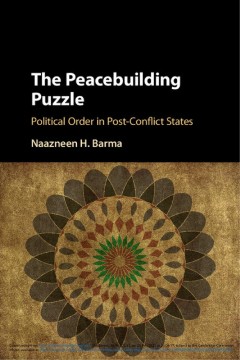
The peacebuilding puzzle : political order in post-conflict states
Transformative peace operations fall short of achieving the modern political order sought in post-conflict countries because the interventions themselves empower post-conflict elites intent on forging a neopatrimonial political order. The Peacebuilding Puzzle explains the disconnect between the formal institutional engineering undertaken by international interventions, and the governance outcom…
- Edition
- -
- ISBN/ISSN
- 9781316718513
- Collation
- xiv, 265p. : ill.
- Series Title
- -
- Call Number
- 355.357 BAR p

Debating humanity : towards a philosophical sociology
Debating Humanity explores sociological and philosophical efforts to delineate key features of humanity that identify us as members of the human species. After challenging the normative contradictions of contemporary posthumanism, this book goes back to the foundational debate on humanism between Jean-Paul Sartre and Martin Heidegger in the 1940s and then re-assesses the implicit and explicit a…
- Edition
- -
- ISBN/ISSN
- 9781316416303
- Collation
- vii, 262p. : ill.
- Series Title
- -
- Call Number
- 128 CHE d
Handbook of stemmatology : history, methodology, digital approaches
Stemmatology studies aspects of textual criticism that use genealogical methods to analyse a set of copies of a text whose autograph has been lost. This handbook is the first to cover the entire field, encompassing both theoretical and practical aspects of traditional as well as modern digital methods and their history. As an art (ars), stemmatology’s main goal is editing and thus presenting …
- Edition
- -
- ISBN/ISSN
- 9783110684384
- Collation
- VI, 668 p.
- Series Title
- -
- Call Number
- 091 HAN h
Dunhuang manuscript culture : end of the First Millennium
Dunhuang Manuscript Culture” explores the world of Chinese manuscripts from ninth-tenth century Dunhuang, an oasis city along the network of pre-modern routes known today collectively as the Silk Roads. The manuscripts have been discovered in 1900 in a sealed-off side-chamber of a Buddhist cave temple, where they had lain undisturbed for for almost nine hundred years. The discovery comprised …
- Edition
- -
- ISBN/ISSN
- 9783110726572
- Collation
- VIII, 289 p.
- Series Title
- -
- Call Number
- 091.095145 GAL d

The future of service post-COVID-19 pandemic, Volume 1 : rapid adoption of di…
This open access book is geared towards providing insights and stimulating new thinking about the changing nature of services, service work and workers, and service experiences during and after the COVID-19 pandemic in 2020, particularly focusing on digital service technology. This book serves as a useful resource for business practitioners and academics in the areas of service and human resour…
- Edition
- -
- ISBN/ISSN
- 9789813341265
- Collation
- XII, 225 p
- Series Title
- The ICT and Evolution of Work,
- Call Number
- 330.9 FUT f
Using ostraca in the ancient world : new discoveries and methodologies
Throughout Egypt’s long history, pottery sherds and flakes of limestone were commonly used for drawings and short-form texts in a number of languages. These objects are conventionally called ostraca, and thousands of them have been and continue to be discovered. This volume highlights some of the methodologies that have been developed for analyzing the archaeological contexts, material aspect…
- Edition
- -
- ISBN/ISSN
- 9783110712902
- Collation
- VI, 245 p.
- Series Title
- Materiale Textkulturen, 32
- Call Number
- 930 USI u
Deep carbon : past to present
Carbon is one of the most important elements of our planet, and ninety percent of it resides inside Earth's interior. This book summarizes ten years of research by scientists involved in the Deep Carbon Observatory, a global community of 1200 scientists. It is a comprehensive guide to carbon inside Earth, including its quantities, movements, forms, origins, changes over time, and impact on plan…
- Edition
- -
- ISBN/ISSN
- 9781108677950
- Collation
- xv, 669p. : ill.
- Series Title
- -
- Call Number
- 549.27 DEE d
Textbook of patient safety and clinical risk management
Implementing safety practices in healthcare saves lives and improves the quality of care: it is therefore vital to apply good clinical practices, such as the WHO surgical checklist, to adopt the most appropriate measures for the prevention of assistance-related risks, and to identify the potential ones using tools such as reporting & learning systems. The culture of safety in the care enviro…
- Edition
- -
- ISBN/ISSN
- 9783030594039
- Collation
- xiii, 496p. : ill.
- Series Title
- -
- Call Number
- 616 TEX t
 Computer Science, Information & General Works
Computer Science, Information & General Works  Philosophy & Psychology
Philosophy & Psychology  Religion
Religion  Social Sciences
Social Sciences  Language
Language  Pure Science
Pure Science  Applied Sciences
Applied Sciences  Art & Recreation
Art & Recreation  Literature
Literature  History & Geography
History & Geography